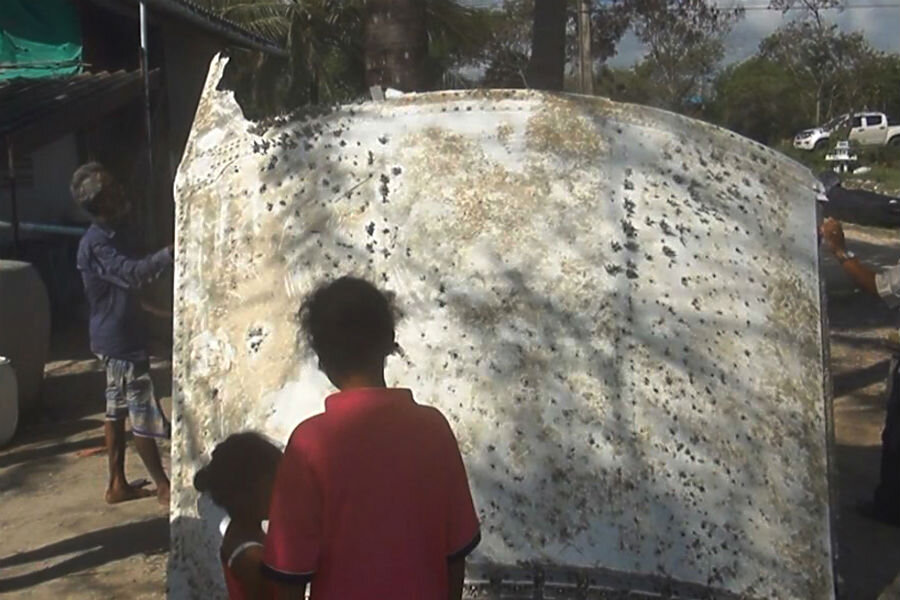Metal debris on Thai beach not likely to be MH370, says Japan rocketmaker
Loading...
| Tokyo
A Japanese rocket maker said Monday that a large piece of metal that washed up on a beach in Thailand is likely part of a rocket launched by Japan, not a missing Malaysian plane.
The discovery of the metal sparked speculation that it might be from Malaysia Airlines Flight 370, which disappeared almost two years ago.
Mitsubishi Heavy Industries said the metal piece is "highly likely" to be part of a Japanese H-IIA or H-IIB rocket that was launched from southern Japan, based on an initial examination of photos and videos of the object.
Company spokeswoman Sayo Suwashita said officials are trying to determine which rocket and its launch date. Rocket debris falls into the ocean after every launch, and most is collected but sometimes pieces can be found some distance from the launch site, including in foreign waters, she said.
Thai air force and civil aviation authorities said Monday they were unaware of the statement from Japan, while the agency within the Transport Ministry that investigates aviation accidents was unavailable for comment.
Japan has launched H-IIA and H-IIB rockets since the 2000s. The most recent H-IIA launch was in November 2015.
Flight 370 took off from Malaysia in March 2014. It lost communications and made a sharp turn away from its Beijing destination before disappearing. While debris can drift thousands of miles (kilometers) on ocean currents, that location would be a surprise based on the data from Flight 370. The presumed crash site in the Indian Ocean and the fact the wing piece was found on Reunion Island near Africa, mean it would be highly unlikely any current could have carried a piece of the missing plane to Thailand's eastern coast.
Malaysian Transport Minister Liow Tiong Lai said Sunday that the search for the missing jet, which carried 239 people, is ongoing in the Indian Ocean and that its second phase is expected to be completed by June. Australia has led a multinational search that has so far cost more than $120 million.
Aviation experts from Malaysia visited Nakhon Si Thammarat on Monday to inspect the metal piece, after which the Thai air force flew it to Bangkok for further examination.
Liow said the search for the missing jet, which carried 239 people, is ongoing in the southern Indian Ocean and that its second phase is expected to be completed by June. Australia has led a multinational search that has so far cost more than $120 million.
Australian Transport Safety Bureau spokesman Dan O'Malley said the agency was awaiting results of an official examination of the debris.
The bureau announced Monday that the search of 120 square kilometers (46,000 square miles) of seabed where the Boeing 777 is thought to have crashed had been set back after a ship lost its sonar equipment.
The Fugro Discovery, one of three ships conducting the search, towed its side-scan sonar into a mud volcano that rose 2,200 meters (7,200 feet) from the sea floor on Sunday, the bureau said in a statement.
The ship lost the sonar plus 4.5 kilometers (14,800 feet) of cable. The ship was now making a six-day journey to the Australian port of Fremantle to collect new cable and would continue the search with spare sonar equipment.
The plane was tracked by radar flying over the South China Sea then making a sharp turn west for unknown reasons. It crossed the Malay Peninsula and Straits of Malacca, which would put it off Thailand's west coast.
Radar contact was lost shortly after the plane entered the airspace over the Indian Ocean. Analysis of exchanges between its engine and a satellite determined the plane flew south on a straight path for hours, leading authorities to believe it flew on autopilot until it ran out of fuel and crashed into the water.
___
Associated Press writers Grant Peck in Bangkok, Eileen Ng in Kuala Lumpur, Malaysia, and Rod McGuirk in Canberra, Australia, contributed to this report.







